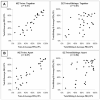Quantification of the relative contribution of environmental and genetic factors to variation in cystic fibrosis lung function
- PMID: 20580019
- PMCID: PMC2948620
- DOI: 10.1016/j.jpeds.2010.05.018
Quantification of the relative contribution of environmental and genetic factors to variation in cystic fibrosis lung function
Abstract
Objective: To assess the relative contributions of environmental and genetic factors to variation in cystic fibrosis (CF) lung disease.
Study design: Genetic and environmental contributions were quantified by use of intrapair correlations and differences in CF-specific forced expiratory volume in 1 second measures from 134 monozygous twins and 272 dizygous twins and siblings while in different living environments (ie, living with parents vs living alone), as well as by use of intraindividual differences in pulmonary function from a separate group of 80 siblings.
Results: Pulmonary function among monozygous twins was more similar than among dizygous twin and sibling pairs, regardless of living environment, affirming the role of genetic modifiers in CF pulmonary function. Regression modeling revealed that genetic factors account for 50% of pulmonary function variation, unique environmental or stochastic factors (36%), and shared environmental factors (14%; P < .0001). The intraindividual analysis produced similar estimates for the contributions of the unique and shared environment. The shared environment effects appeared primarily because of living with a sibling with CF (P = .003), rather than factors within the parental household (P = .310).
Conclusions: Genetic and environmental factors contribute equally to pulmonary function variation in CF. Environmental effects are dominated by unique and stochastic effects rather than common exposures.
Copyright © 2010 Mosby, Inc. All rights reserved.
Figures





References
-
- Riordan JR, Rommens JM, Kerem B, Alon N, Rozmahel R, Grzelczak Z, et al. Identification of the cystic fibrosis gene: cloning and characterization of complementary DNA. Science. 1989;245:1066–73. - PubMed
-
- Kerem B, Rommens JM, Buchanan JA, Markiewicz D, Cox TK, Chakravarti A, et al. Identification of the cystic fibrosis gene: genetic analysis. Science. 1989;245:1073–80. - PubMed
-
- Koch C, Cuppens H, Rainisio M, Madessani U, Harms H, Hodson M, et al. European Epidemiologic Registry of Cystic Fibrosis (ERCF): comparison of major disease manifestations between patients with different classes of mutations. Pediatr Pulmonol. 2001 Jan;31:1–12. - PubMed
-
- Kerem E, Corey M, Kerem B-S, Rommens J, Markiewicz D, Levison H, et al. The relation between genotype and phenotype in cystic fibrosis--analysis of the most common mutation (deltaF508) N Engl J Med. 1990;323:1517–22. - PubMed
-
- Cystic Fibrosis Genotype/Phenotype Consortium Correlation between genotype and phenotype in cystic fibrosis. N Engl J Med. 1993;329:1308–13. - PubMed
Publication types
MeSH terms
Grants and funding
LinkOut - more resources
Full Text Sources
Other Literature Sources
Medical

